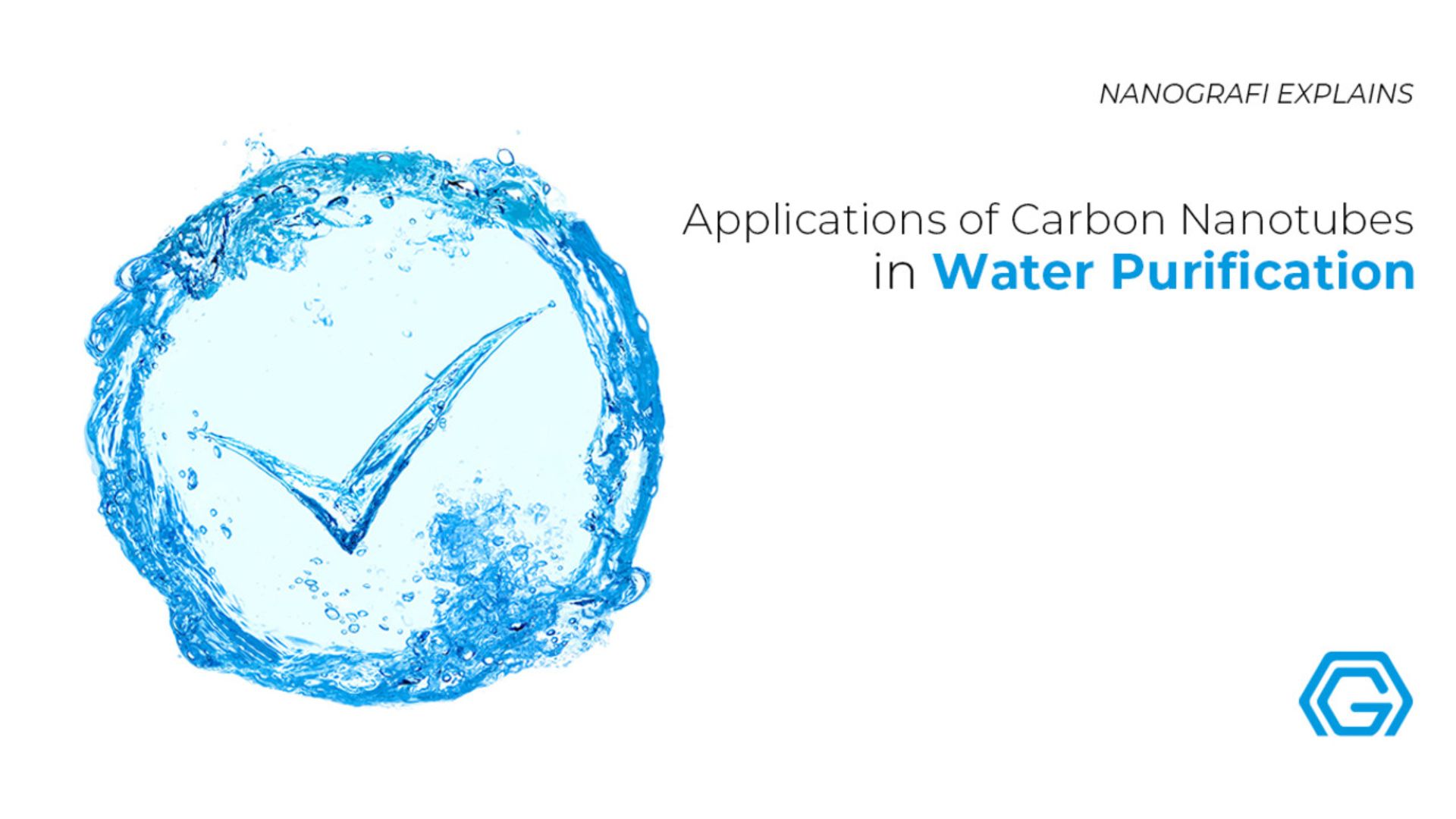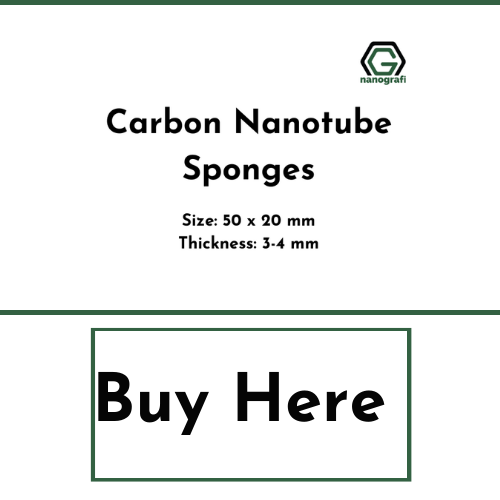Carbon Nanotube (CNT) Sponges
Carbon nanotubes (CNTs) are nanoscale, strong and hollow cylinders which shows excellent mechanical and electrical properties.
Based on their orientation and configuration in the structure, they can be used in many practical applications such as supercapacitors, catalytic electrodes, flexible heaters, superhydrophobic coatings, biomimetic surfaces, artificial muscles, and integrated microelectromechanical systems.
Introduction
These different forms of CNTs can be vertically aligned arrays via direct growth, long fibers or sheets yarned from CNT forests, solids and wafers densified from aligned films, solution-processed aerogels and thin films. All of these forms of CNTs show different properties since their alignments, densities and porosities are different. CNTs can be considered as superior sorbents for a wide range of organic chemicals and inorganic contaminants than conventional systems such as clay and activated carbon, with a number of advantages including stronger chemical-nanotube interactions, rapid equilibrium rates, high sorbent capacity and tailored surface chemistry.
Carbon Nanotube (CNT) Sponges
NT sponges are made up of interconnected carbon nanotubes where the CNTs are self-assembled into a three-dimensionally interconnected framework. CNT sponges are novel materials that are low density, lightweight, high surface area and high porosity which makes them useful in many applications. Their porosity is larger than %99. Also, they have very high structural flexibility, robustness and wettability to organics. The structural integrity under large deformations is owing to the highly interconnected CNTs in a three-dimensionally isotropic configuration, which could prevent the sliding or splitting between CNTs along any direction They can be deformed into any shape elastically by applying very large strains. They can absorb wide range of solvents and oils with excellent selectivity, recyclability, and absorption capacities up to 180 times their own weight which makes them an outstanding candidate for the environmental clean-up applications.
CNT sponges are produced by chemical vapor deposition (CVD) method in which a precursor solution of ferrocene in dichlorobenzene was injected for four hours. The CNT sponges display structural flexibility that was rarely observed in other high-porosity materials (e.g., aerogels) or aligned CNT arrays. Manual compression to >50% volume reduction shows that the sponge is malleable and springy. A bulk sponge can be bent to a large degree or twisted without breaking apart, and after that still recover to nearly original shape. The conservation of structural integrity after large deformations is owing to the highly interconnected CNTs in a three-dimensionally interconnected framework, which could prevent the sliding or splitting between CNTs along any direction.
In addition to superior mechanical properties of CNT sponges, their high electrical conductivity is also another superior property that makes them an outstanding candidate for many applications. Besides their environmental clean-up applications such as large area oil spill cleanup, purification of water, and treatment of waste oil since they are highly hydrophobic and oleophilic materials, they can be used in sensors, smart materials and compressible conductors due to their high electrical conductivity.
nother important property of these CNT sponges is that they can be ferromagnetic by filling iron into the small capsules within a single carbon shell in the synthesis process. This property can be used to direct CNT sponge or control their whereabouts. Thus, they can be separated with the help of a magnet from oil, water or any liquid which is beneficial for cleaning oil spills or water purification. CNT sponges are not only used to absorb oil, they could also potentially be used to remove bacteria or contaminants from other liquids. In the case of a fuel spills, CNT sponges can absorb fuel from the water and this absorbed fuel can be used by burning the CNT sponge. At the end of this burning process CNT sponges can be used again which implies their reusable feature.
Compared to other conventional cellular materials, CNT sponges show excellent mechanical properties and high stability: high strength-to-weight ratio, superelasticity, thermomechanical strength over a wide temperature range, very low stress relaxation under high pressure, excellent resistance to fatigue and electromechanical stability under mechanical compression. The sponge structure is uniform with excellent mechanical strength, excellent flexibility, high porosity and low density.
To get more information about the utilizations of carbon nanotubes,
you can read our blog post here.
CNT sponges are great thermal insulators. Although carbon nanotubes are good thermal conductors, CNT sponges are thermal insulators due their highly porous nature. Their thermal conductivity is lower than other insulators such as foams or woods. Therefore, superior properties of CNT sponges such as good thermal stability, electrical conductivity, robustness, resistance against harsh environment and super-elasticity makes them candidate material for many applications.
As mentioned above, CNTs can be transformed into different shapes such as sheets, long fibers, thin films, sponges etc. Depending on the orientation and shape of the CNTs application are could vary. CNT sponges could be an alternative material which for many applications. CNT sponges could be used in environmental applications such as sorption, filtration and separation. Also, they could be used in batteries. These applications are mentioned below.
Oil Spill Cleanup
Oil spills, defined as the leakage of petroleum onto the surface of large bodies of water, are a major global issue. There are a multitude of causes that contribute to the severity of this problem, including the drilling of petroleum carried out in or near the sea, the leakage of fuel from water sports or vehicles, leakage of products containing petroleum on land into the ocean, and equipment faults of oil tankers. Combined with the natural seepage from the ocean, these sources add to the world’s waterways at a rate of 3.5 to 6 million metric tons a year. Scientists have attempted to search for a method that can effectively clean the spill and help to alleviate the damage. Although many methods have failed, in recent decades, scientists have spent much time altering the structure of carbon nanotubes. Carbon nanotubes have acquired the potential to be used as one of the primary processes for cleaning up oil spills. They originally caught the attention of scientists due to their high strength, conductivity, as well as their lightweight structure. By altering the structure of the carbon nanotube in this way, it begins to grow into a woven sponge-like material that is three-dimensionally strong and efficient at absorbing oil because it attracts oil while repelling water. Also, ferromagnetic properties of CNT sponges allow for easy control or removal externally during the cleanup of oil spills. Therefore, CNT sponges could be a solution for oil spills due to its low density which allow for CNT sponges to float on the surface of the water by absorbing only the oil. Other properties such as large surface area, high porosity and elasticity make CNT sponges potential solution for these problems.
Water Purification
CNT sponges can absorb any other organic contaminants present in water. These features can be used in the purification of polluted water which occurs as a result of an industrial accident or marine litter. Once CNT sponges are saturated with oil, oil can be eliminated by quickly squeezing the sponge and releasing the oil, the sponges can then be used again. Moreover, CNT sponges can absorb fuel present in water can be used by burning CNT sponge which will conserve its structure and properties after burning the fuel. It can be used again and again.
Catalyst
CNT sponges are alternative materials for catalysis, acting either as catalyst themselves or as active sites for selected catalysts. High surface area of CNT sponges offer large number of active sites and they can boost reaction kinetic due to its high electrically conductive nature. Also, their mechanical and chemical stability increases cycle life of catalysts.
Energy Storage
CNT sponges can be used in Li-ion batteries in the bulk form instead of graphene which is used nowadays. In Li-ion batteries, Li ions are passed through electrolyte to the graphene structure to be stored. This process is called intercalation. They are stored in negative electrodes. Negative electrode should have high specific surface area, mechanical strength, chemical stability and electrically conductive for the electron transfer. CNT sponges offer these properties which boost battery performance by providing high energy density, high C-rate capability and long cycle life.
Conclusion
Carbon nanotube sponges (CNTs) are materials made up of CNTs which are interconnected in 3-D framework. CNT sponges are produced by chemical vapor deposition (CVD). Their superior properties such as high surface area, high porosity, low density, high strength to weight ratio etc. make them candidate or alternative material for many applications. In addition to these properties, their mechanical and chemical stability, being ferromagnetic material or being thermal insulator boost the performance of CNT sponges for a chosen application.
Due to hydrophobic and oleophilic nature of CNT sponges, application areas of CNT sponges range from environmental cleanup to high-tech applications such as smart materials, sensors or batteries. All in all, CNT sponges are novel materials to be used in various applications that have gained interest for the last years.
To get more information, you can visit Blografi.
References
- Gui, X., Wei, J., Wang, K., Cao, A., Zhu, H., Jia, Y., … Wu, D. (2010). Carbon Nanotube Sponges. Advanced Materials, 22(5), 617–621. doi:10.1002/adma.200902986
- Nanosponges soak up oil again and again. (n.d.). Retrieved July 21, 2020, from http://news.rice.edu/2012/04/16/nanosponges-soak-up-oil-again-and-again-2/
- Multi Walled Carbon Nanotube Dispersions. (n.d.). Retrieved July 21, 2020, from https://blog.metu.edu.tr/e188043/multi-walled-carbon-nanotube-dispersions/
- Cortés-López, A. J., Muñoz-Sandoval, E., & López-Urías, F. (2018). Efficient carbon nanotube sponges production boosted by acetone in CVD-Synthesis. Carbon,135, 145-156. doi:10.1016/j.carbon.2018.04.046
- Physics, I. (n.d.). Retrieved July 21, 2020, from https://www.iop.org/news/14/jan/page_62331.html
- Nanotube sponges: Clean it up. (2010, February 22). Retrieved July 21, 2020, from https://www.nature.com/articles/asiamat2010106
Pan, B., & Xing, B. (2008). Adsorption Mechanisms of Organic Chemicals on Carbon Nanotubes. Environmental Science & Technology,42(24), 9005-9013. doi:10.1021/es801777n
Recent Posts
-
Advanced Materials for Unmanned Aerial Vehicle (UAV) Protection Against Laser
Consider a UAV on a critical mission, rendered inoperative by a sudden laser attack. With the increa …26th Jul 2024 -
Simulation and Modeling of Material Properties
Our world is composed of a dazzling array of materials, each with its own unique properties that dic …19th Jul 2024 -
Advanced Coatings for Superior Corrosion and Wear Resistance
Corrosion and wear pose significant challenges across various industries, leading to substantial eco …12th Jul 2024







